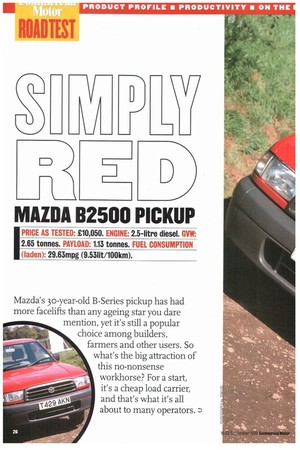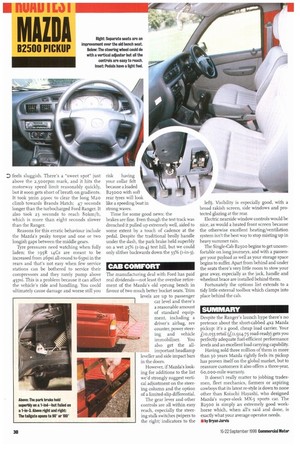MAZDA B2500 PICKUP
Page 30

Page 32

Page 34

If you've noticed an error in this article please click here to report it so we can fix it.
IPRICE AS TESTED: £10,050. ENGINE: 2.5-litre diesel. GM: 2.65 tonnes. PAYLOAD: 1.13 tonnes. FUEL CONSUMPTION (laden): 29.63mpg (9.531it/100km).
Mazda's 30-year-old B-Series pickup has had more facelifts than any ageing star you dare mention, yet it's still a popular choice among builders, farmers and other users. So what's the big attraction of this no-nonsense workhorse? For a start, it's a cheap load carrier, and that's what it's all about to many operators.
azcia began supplying the UK with one-tonne pickups in 1973, at a time when we still built our own commercials but our manufacturers believed that our transport industry certainly didn t need such piddlin' little trucks. In next to no time Mazda was joined by Toyota and Mitsubishi and the one-tonne market steadily grew, until io years later there was a whole rash of Oriental pickups about including the Subaru, the Honda Acty---even a little Pony from Hy-undai.
Once the threat was perceived the home team fought back with the ubiquitous Transit, Freight Rover's Sherpa, Austin Morris's 575, Dodge's Iwo and the odd little Bedford KB26. But Mazda's only real opposition came from Peugeot's sturdy 504 pickup and the Ford ProoL.
Peugeot seems to have bowed out of a niche market worth some 8,5oo units in a good year, but Mazda and Ford have bitten the bullet by collaborating in a joint manufacturing deal in Thailand. The plant there produces virtually the same pickup, with Mazda's B2500 sharing its basic body structure and running gear with Ford's version, the Ranger
PRODUCT PROFILE
Over the years we've built up a hefty dossier on Mazda's pickup with a succession of road tests and evaluations. We first sampled the 70hp B1600 in June 1973. Although we weren't impressed by the sprung bench seat and the under-powered r.6-litre petrol engine, it was well finished and looked like a rugged performer. At £1,148 it seemed a snip; four years later the loadbed was a foot longer but it was nigh on twice the price at12.,267.
By 1985 Mazda's B2200 had a 44hp (33kW) 2.2-litre diesel engine and was doing slightly better on fuel consumption, but the price had skyrocketed to L7,2o4.
So what's changed since then? Well, the price has nudged into five figures but the redesign has given it a degree of sophistication while retaining that familiar cab/chassis/body build structure.
The B.25oo range comprises four basic models: a Single Cab with a 76hp (57kW) naturally aspirated diesel engine in two or fourwheel drive; a 4x4 Double Cab; and a recre
ational vehide called the 4Action. The Mazda and Ford versions of the 4x4s both have slightly larger wheels and a more aggressive look than our Single Cab 4x2 test vehicle. The 4x2 is also lower, and the old butt-front has been replaced by a more stylish profile.
Under the bonnet the 2.5-litre, 76hp IDI diesel is fairly high revving, delivering maximum power at 4,roorpm (the red band starts at 5,000rpm) with 168Nm (1241bft) of torque at 2,500rpm.
The B2500 has a five speed synchromesh gearbox with a 0.825:1 overdrive top gear driving through to the rear axle.
Viewed from the rear our Single Cab 4x2 has hardly changed over the years. Its shallow steel body tray has the same swaged shape, 90/1800 tailgate and cleated tie bars that we encountered so years ago, but it looks sturdy enough and, at 2.28m, is among the longest in its class. A Truckman top makes the load weatherproof and a sight more secure too.
PRODUCTIVITY
The B2500 with its naturally aspirated diesel engine is hardly a sophisticated drive but it shines where it matters—in fuel economy and carrying capacity.
Driven around our busy Kent light vehicle test route in dry weather and loaded to its 2.65-tonne gross vehicle limit the Mazda returned 29.63mpg. That's well above average for this type of vehicle, as indeed is the 34.impg for its unladen run.
But pickup users want to haul large amounts of tools, materials or produce around so the B2.500's carrying capacity of 1,055kg, allowing a modest 75kg for a driver, makes it a one-tonne pickup in the strictest sense.
Although the body sides are somewhat shallow its 2.28m loadbed is one of the longest on offer, second only to the Vauxhall Brava's 2.3m. With a 980kg front axle and 1,750kg on the rear there's not a deal of tolerance on axle limits, so position your load evenly. Its not enough to simply lash a small but heavy load down behind the cab.
Oddly enough Mazda doesn't quote a price for a driver's door mirror but allowing, say, £5o, the M2500's basket of parts costs a little less than most of its competitors. Better still, it carries a standard three-year, 6o,000-mile warranty that includes full round-the-clock roadside assistance and service backup from 150 dealers across the UK.
ON THE ROAD
Our sample B25 000 proved an easy drive with lightly weighted pedals, an easy clutch movement and slick gear changes. The standard powered steering was also light and responsive, all of which was a contrast with the engine's performance.
Compared with the more flexible turbo-diesel in Mazda's double-cabbed 4x4, the unblown 12-valve diesel 0 feels sluggish. There's a "sweet spot" just above the 2,500rpm mark, and it hits the motorway speed limit reasonably quickly, but it soon gets short of breath on gradients. It took 3min 29sec to clear the long Mao climb towards Brands Hatch; 47 seconds longer than the turbocharged Ford Ranger. It also took 23 seconds to reach 80km/h, which is more than eight seconds slower than the Ranger.
Reasons for this erratic behaviour include the Mazda's peaky torque and one or two longish gaps between the middle gears.
Tyre pressures need watching when fully laden; the 195R 14Cs are meant to be increased from 26psi all-round to 63psi in the rears and that's not easy when few service stations can be bothered to service their compressors and they rarely pump above 45psi. This is a problem because it can affect the vehicle's ride and handling. You could ultimately cause damage and worse still you risk having your collar felt because a loaded B25000 with soft rear tyres will look like a speeding boat in strong waves.
Time for some good news: the brakes are fine. Even though the test track was drenched it pulled up extremely well, aided to some extent by a touch of cadence at the pedal. Despite the traditional brolly handle under the dash, the park brake held superbly on a wet 25% (i-in-q.) test hill, but we could only slither backwards down the 33% (i-in-3).
CAB COMFORT
The manufacturing deal with Ford has paid real dividends—not least the overdue retire ment of the Mazda's old sprung bench in favour of two much better bucket seats. Trim levels are up to passenger car level and there's a reasonable amount of standard equipment, including a driver's airbag, rev counter, power steering and vehicle immobiliser. You also get the allimportant headlamp leveller and side impact bars in the doors.
However, if Mazda's looking for additions to the list we'd strongly suggest vertical adjustment on the steering column and the option of a limited-slip differential. The gear lever and other controls are all within easy reach, especially the steering stalk switches (wipers to the right indicators to the left). Visibility is especially good, with a broad rakish screen, side windows and protected glazing at the rear.
Electric nearside window controls would be nice, as would a heated front screen because the otherwise excellent heating/ventilation system isn't the best way to stop misting up in heavy summer rain.
The Single-Cab 132500 begins to get uncomfortable on long journeys, and with a passenger your payload as well as your storage space begins to suffer. Apart from behind and under the seats there's very little room to stow your gear away, especially as the jack, handle and wheelnut brace are installed behind them.
Fortunately the options list extends to a tidy little external toolbox which clamps into place behind the cab.
SUMMARY
Despite the Ranger's launch hype there's no pretence about the short-cabbed 4x2 Mazda pickup: it's a good, cheap load carrier. Your L10,055 retail (L1,914.75 road-ready) gets you perfectly adequate fuel-efficient performance levels and an excellent load carrying capability.
Having sold three million of them in more than 30 years Mazda rightly feels its pickup has proven itself on the global market, but to reassure customers it also offers a three-year, 6o,000-mile warranty.
It doesn't really matter to jobbing tradesmen, fleet mechanics, farmers or aspiring cowboys that its latest re-style is down to none other than Koiuchi Hayashi, who designed Mazda's super-sleek MX-5 sports car. The B2500 is simply an extremely good workhorse which, when all's said and done, is exactly what your average operator needs.
II by Bryan Jarvis










































































































